News for 03 June 2020
All the news for Wednesday 3 June 2020
24 years of Fieldhockey.com
Today is the 24th anniversary of the founding of Fieldhockey.com.
Started as a challenge that there was very little hockey news ever published, the aim of the site has always been to publish at least one hockey story per day - a challenge that has been met every single day since 13 August 1996 (apart from two glitches when I was on a weekend break and there was no internet access intuit area, though I corrected the problem as soon as I got back, And earlier this year when my server suffered a hard drive failure for a day - again restored the next day)
Normally the only time that it has been difficult has been over Christmas and New Year, but recently during the Covid-19 crisis, with no hockey being played worldwide, it has been a very difficult time. Fortunately most of the top Hockey reporting papers and many of the National Associations have done a sterling job in keep interest in the sport alive and for that I am sure we are very grateful.
Many thanks for your support over the last 24 years, but more especially to Lance Forkgen of Just Hockey Australia for their sponsorship of the site and the hard work of contributing journalists, without which this would not be possible.
FIH change qualification process for 2022 and 2023 Hockey World Cups
By Liam Morgan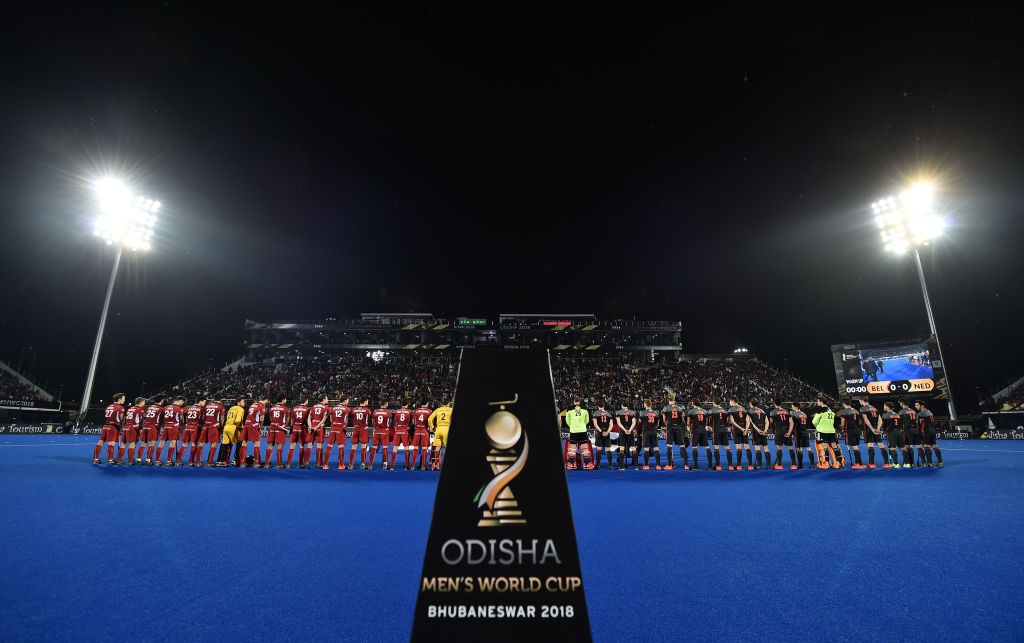
The FIH has altered the qualification process for the 2022 and 2023 World Cups ©Getty Images
The International Hockey Federation (FIH) has altered the qualification process for its World Cups in 2022 and 2023 following the postponement of the Tokyo 2020 Olympic Games.
The FIH has increased the number of quota places for the two tournaments which are available through Continental Championships from six to 11.
Traditionally, only the winner of each Continental Championship has been awarded an automatic World Cup berth.
The top four nations in the women's event, including co-hosts Spain and The Netherlands, at the 2021 EuroHockey Championship, moved to avoid a clash with the new Tokyo 2020 dates, will now secure a place at the 2022 World Cup.
Two will qualify from Asia, Oceania and Pan America, while the winner of the African event will be given the continent's sole World Cup quota.
Europe will also have at least four places at the 2023 Men's Hockey World Cup, set to take place in India.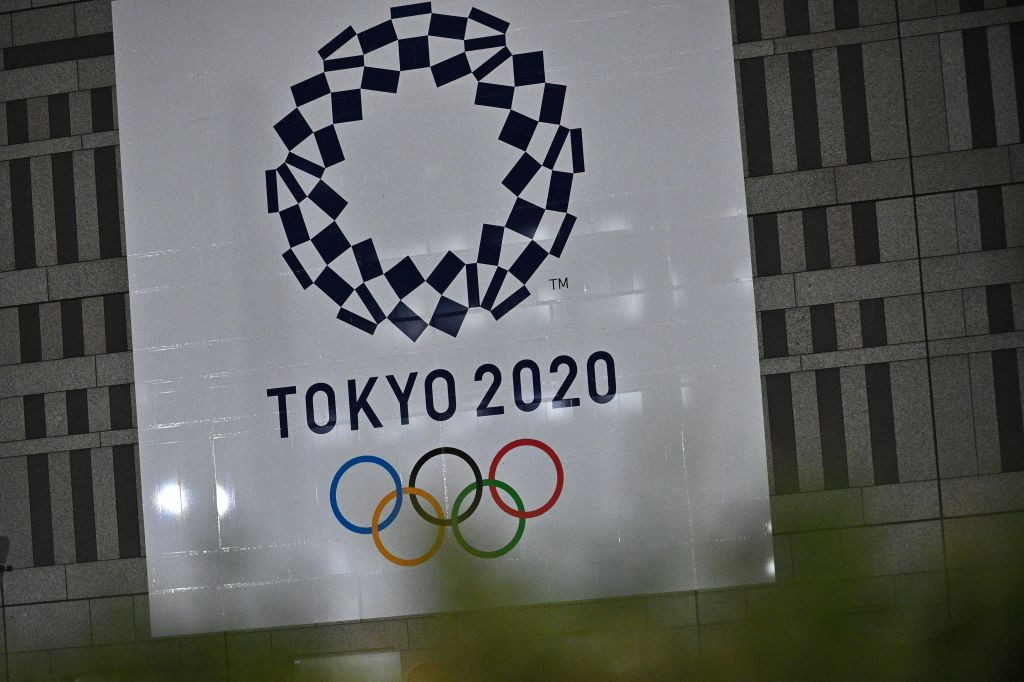
The postponement of the Tokyo 2020 Olympics has had a significant impact on International Federations ©Getty Images
Three – including one reserved for the host nation – will be on offer at the 2021 Asia Cup, while two will qualify at the corresponding event in Oceania.
They will be joined by the winners of the Pan American Cup and the Africa Hockey Cup of Nations.
Stand-alone qualifiers will be organised to fill the remaining five spots at each of the women's and men's events.
The FIH had been set to hold home-and-away play-offs to determine the remaining nations at each competition, but this appears to have been shelved.
The process for the two events also differs from the last Men's and Women's World Cups, held in 2018.
Eleven and 10 places for the men's and women's tournaments, respectively, were awarded through the now-defunct Hockey World League.
The coronavirus crisis and Tokyo 2020 being pushed back by a year has forced International Federations into a considerable reshuffle of their event calendars.
Inside the Games
World Cup qualification: FIH to allocate more spots for continental events
While 11 of the 16 spots would be filled through the five continental championships, the remaining five would be decided through FIH qualification events.
The postponement of the 2020 Tokyo Olympics and the scrapping of Hockey World League competition has forced the FIH to rework its qualification process for the next edition of the World Cup, allocating more spots to continental events.
The International Hockey Federation’s Executive Board on Tuesday issued the fresh qualification process to finalise teams for the 2022 Women’s and 2023 Men’s World Cups. While 11 of the 16 spots would be filled through the five continental championships, the remaining five would be decided through FIH qualification events, to be held in March 2022.
The changed rules now allow both finalists at the 2021 women’s Asia, Oceania and Pan-American Championships to qualify for the World Cup while for the men, Asia gets an extra spot at PanAm’s expense.
Host India (for men) and joint hosts Holland and Spain (for women) qualify automatically, as before. The continental quota places for the FIH qualification events to decide the remaining five spots, however, would be confirmed later.
This is the first time more than one spot has been allotted to continental events in recent years with the increase in number of teams from 12 to 16 at the 2018 edition too playing a role.
For the past two editions, a majority of spots were filled through the World League while various forms of qualifying events were held before that.
Revised continental quotas:
Women: Africa 1, Asia 2, Europe 4 (including hosts Holland and Spain), Oceania 2, PanAm 2.
Men: Africa 1, Asia 3 (including hosts India), Europe 4, Oceania 2, PanAm 1.
Sportstar
Hockey India recommends Rani Rampal for Khel Ratna
Team S2H 
New Delhi: Hockey India on Tuesday announced the nomination of Indian Women’s Hockey Team Captain Rani for the prestigious Rajiv Gandhi Khel Ratna Award while her compatriots Vandana Kataria, Monika and Harmanpreet Singh have been nominated for the Arjuna Award. For the Major Dhyan Chand Award for Lifetime Achievement, Hockey India has recommended former India stalwarts Dr RP Singh and Tushar Khandker. Coaches BJ Kariappa and Romesh Pathania have been nominated for the Dronacharya Award.
In the period for consideration for the Rajiv Gandhi Khel Ratna Award (2016 to 2019), Rani has led the Indian women’s hockey team to historic victories in the Women’s Asia Cup in 2017, Silver at the 2018 Asian Games and played a critical role in the FIH Olympic Qualifiers in 2019 by scoring the deciding goal that helped in India’s qualification for the Tokyo Olympics.
In this period, the Indian Women’s Hockey Team also climbed to a career-best FIH World Ranking of No.9. First from India to be named as the World Games Athlete of The Year 2019, Rani has also been the recipient of the Arjuna Award in 2016 and the prestigious Padma Shri award in 2020.
Vandana Katariya
Meanwhile, striker Vandana Katariya who has over 200 International Caps and Monika with over 150 International Caps, both recommended for the Arjuna Award, have played key roles in the Indian Team’s sensational wins in 2019 which include the FIH Series Finals in Hiroshima, Tokyo 2020 Olympics Test Event and the FIH Hockey Olympic Qualifiers in Bhubaneswar.
Indian Men’s Hockey Team dragflick sensation Harmanpreet Singh, also shortlisted for the prestigious Arjuna Award, stepped up his role in the team and shouldered the responsibility of Vice Captain with aplomb. As a defender-dragflicker he was instrumental in the team’s winning performance in the FIH Series Finals in Odisha. At the Tokyo 2020 Olympics Test Event, he captained the team to victory in the absence of Manpreet Singh who was rested for the tournament. Harmanpreet was also part of the Indian team that won the FIH Hockey Olympic Qualifiers against Russia last year.
While former India stars Dr RP Singh and Tushar Khandker’s continued contribution in the field of Hockey has led to their recommendation for the Major Dhyan Chand Award for Lifetime Achievement, BJ Kariappa who is nominated for the Dronacharya Award has Coached the Indian Junior Men’s Team to Silver Medal at the Sultan of Johor Cup in 2019. Romesh Pathania, on the other hand, continues to serve the sport as Coach of Punjab National Bank.
Monika
Speaking about Hockey India’s recommendations for the prestigious National Awards, Hockey India President Mohd Mustaque Ahmad said, “Sardar Singh was the last hockey player to win the Rajiv Gandhi Khel Ratna Award. Rani has set new benchmarks in Women’s Hockey and we at Hockey India feel she is very deserving of the top award. We are happy to endorse Vandana Katariya, Monika and Harmanpreet Singh for the Arjuna Award for their excellent performance for India in 2019. Dr RP Singh and Tushar Khandker nominated for the Major Dhyan Chand Award for Lifetime Achievement and Coaches BJ Kariappa and Romesh Pathania nominated for the Dronacharya Award have contributed to Indian Hockey in their respective roles as players, administrators and coaches. They contribute to help build the sport and achieve our goals. It is with pride and happiness that Hockey India recommends these names for the prestigious National Awards.”
Stick2Hockey.in
Deserving case for Deep Grace Ekka
By K. Arumugam
Hockey India, in its wisdom, has recommended hockey players for annual Arjuna and other awards. Its heartening that the Indian hockey has now a talent that is potentially a Khel Ratna material – Rani Rampal.
Rani Rampal deserves the Khel Ratna honour.
Hope she gets the approval of the soon-to-be appointed Screening Committee under the aegis of the Ministry of Youth Affairs and Sports.
Vandana Katariya has been in the national teams as a fixture since 2011, though made her senior debut two years ago. She is a byword for fitness and commitment. To me, she is the most deserving case for the Arjuna honour amongst the present lot. She is a self-less distributor and sets up goals for others. She has been a match winner. If not for anything at least her fitness levels, she entail Arjuna.
Hockey India has also recommended second women hockey player, Monika, for Arjuna. We wish the talented midfielder’s case too gets the nod, though it is difficult to say whether two women hockey players will get it in a year. History has to be side-lined for such a feat. I strongly feel two women hockey players should get it every year, even if that meant at the cost of men!
However, without calling the Hockey India’s wisdom into question, I wish proper data analysis is done with respect to recommending second player. In this I presume the second player is not a cover, not strategic but straight forward decision to get two women hockey players in the roll of honour.
There are many players in the team who have longer career and achievements than Monika.
There are only four players in the current lot, who have played more than 200 matches. They are Vandana Katariaya, Rani Rampal, Savita Punia and Deep Grace Ekka. Rani and Savita have already got the Arjuna. Vandana is now recommended.
Who is left out? Deep Grace Ekka.
Deep Grace Ekka has been the national team’s bulwark defender since made international debut in 2011. She was not only in the team in the said period, but also had played in every match. That’s why Deep Grace Ekka had collected her 200th cap within eight years unless other players who took 3 to 4 years more. Let us compare many parameters.
Deep Grace Ekka, who is from Odisha, a State committed to development of hockey, had collected her 200th cap in 2019. That time Monica was trailing her by more than 50 caps!
Not only that there are other players in the team like Nikki Pradhan and Navjot Kaur who are ahead of Monika in terms of number of caps, and longevity of international career.
Deep Grace wore the captain’s armband in the first match of the Belarus Series in 2017. The daring defender was also chosen by Hockey India to lead Junior National team to New Zealand in 2014. Leadership honour still eludes Monika.
Doubling up her role, Deep dug into the rivals’ citadel, and accounts for about 25 goals too. Another feature that eludes in the career of Monika.
Deep Grace entered the senior international arena in 2011, Monika in 2013.
From 2011 to till 2019 OQ in Bhubaneswar, Deep Grace played in a whopping 44 international engagements (tournaments and bilateral Series) while Monika figured almost ten less. Its a huge difference. Significantly, due to whatever reasons, Monika could not make it to the 2014 Commonwealth Games. On the other hand, only tournament Deep Grace missed in her decade long career was the inconsequential SAF Games in Guwahati.
Therefore there is no comparison between the two.
Picking players for special honour in a team game is difficult task. Its subjective. Therefore, its always prudent to be led by the numbers which any player accrues with sweat and toil.
Further, ignoring established seniors in the team and lifting someone else create confusion among freshers and angst among seniors. It impacts the team spirit.
The likes of Deep Grace, Nikki, Lilima or for that matter from anybody will not openly express their feelings. Policy makers have to be sensitive, if not scientific, in their approach.
I fervently hope justice will be done to Deep Grace Ekka at least on any next occasion
Kindly make no mistake the point being driven is to highlight the fact that senior like Deep Grace’s role should also be given importance, certainly not to belittle any contemporary player. After all, bear in mind Monika has played 150 plus internationals which is equivalent to 250 if only women would get as much as opportunity their male counterparts, get.
The moot point is right priority. I advocate seniority here.
Meanwhile, wish Rani Rampal, Vandana Katariya and Monika all the best. Expect wisdom prevails with the Screening or Selection Committee and they accord all the three the award that they richly deserve.
Stick2Hockey.in
Hockey players start ‘socially-distanced’ training after two-month pause
The national team players were supposed to restart training in mid-May, but their wait got prolonged after a SAI staffer passed away and tested positive for the coronavirus.
By Mihir Vasavda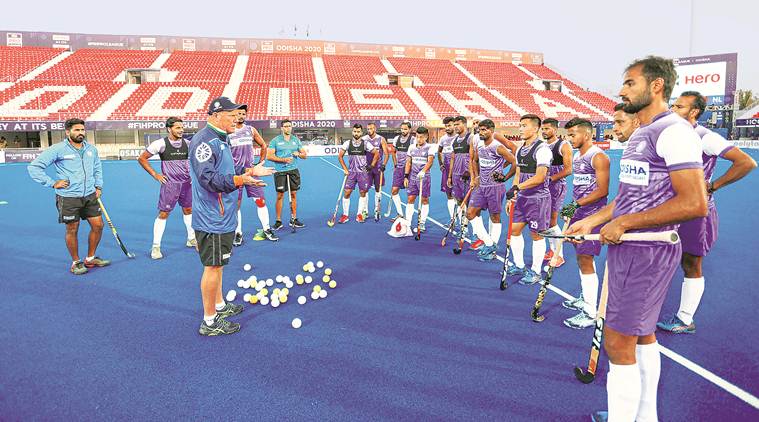
Graham Reid, the head coach, with the men’s hockey team in training. (Source: File Photo)
After nearly 70 days, Indian hockey teams returned to the turf on Monday morning; the first team sport to resume activities since the lockdown was imposed on March 25. It was training like never before, vastly different from what they are used to. But as a player put it, ‘at least we could feel the ball hitting the stick again.’ It was largely just about that.
For more than a month, there had been a growing sense of frustration among the players that they were not being allowed to train despite spending most of the lockdown quarantined inside the Sports Authority of India’s Bengaluru campus. When the government did give them the green signal in mid-May, their wait got prolonged after a SAI staffer passed away and tested positive for the coronavirus. After spending nearly two weeks in isolation since that incident, the players were at last allowed to step on to the field again.
Social distancing protocols mean that the teams have been divided into two groups. Half of them resumed training on the hockey turf while the rest began the ‘unlockdown’ with some fitness drills. A group of woman players, for instance, spent their morning on the football ground where they were given tasks to perform by physio Wayne Parnell. The men, too, followed the same pattern. On Tuesday, both groups will swap their tasks.
Fewer number of players on the field meant full-fledged training was not possible. So, both teams indulged in some very rudimentary drills: passing and receiving. The session lasted nearly an hour and a half. “That was the only thing possible because of the distancing norms. Initially, that’s what our training will look like,” a source said, adding that there was stiffness and soreness of muscles given that outdoor training resumed after a long hiatus.
The coaches and assistant coaches of both teams, too, had to maintain a distance from the players. That meant they could only observe and give instructions from the touchline and not be involved in the action as they usually are during training. After each session, the turf was sprayed with disinfectants.
The source said the teams will gradually get into full-contact training but that will be only after SAI and Hockey India give their go-ahead. Hockey India, in its Standard Operating Procedure for the national teams, had suggested full-contact training for the teams since they had been in quarantine.
India are behind Belgium and the Netherlands by almost a month in terms of restarting training. The 2018 World Cup finalists were given permission by their respective governments last month. Like India, they too had to maintain a minimum distance of 1.5m during their 90-minute session, meaning only passing drills were possible. Australian players, too, have been given the go-ahead to resume training on the turf.
Indian Express
Irish hockey: Physiotherapist Roisin Murphy on adapting the role amid social distancing
By Nigel Ringland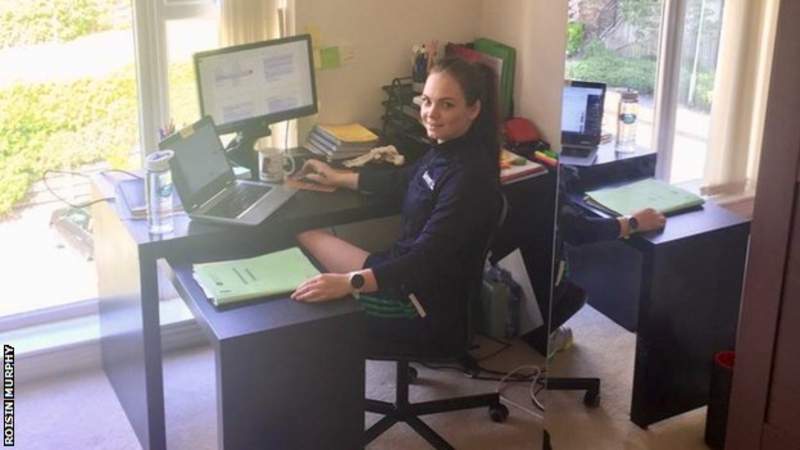
The lockdown has forced Murphy to adjust the way she works as she swaps face-to-face meetings with athletes for a home office
Throughout the Covid-19 lockdown we've heard a lot from athletes about how they've been coping with everything from the lack of training facilities to the Olympics postponement.
But what about the group of committed individuals who in normal times are responsible for making sure Northern Ireland's top sports stars can compete at the highest level?
Sport NI Sport's Institute Physiotherapist Roisin Murphy works with a number of athletes but since the start of 2018 has been an integral member of the Ireland Women's Hockey backroom team.
Murphy been with the team for their World Cup silver medal winning campaign and the history-making Olympic qualification last November.
Like everyone else the 33 year-old has been in lockdown since March, living in Belfast and unable to return to her home village of Silverbridge in County Armagh where she regularly plays football for her local GAA club.
In literally a 'hands-on' job she has had to be innovative and find new ways to liaise with the athletes she is used to seeing on a daily basis.
"The restricted ability to assess an injury can be tricky," admits Murphy.
"We rely on our hands, our touch and our eyes to pick up what can sometimes be very subtle things when assessing an athlete and doing this remotely has really challenged the way I work.
"However positively in our profession there is a lot of evidence based literature to support accurate diagnosis from what athletes are telling you and how they describe their pain and functional abilities.
"The power of communication cannot be emphasised enough and although you are losing the nonverbal across a computer screen it forces you to listen more as a clinician which in a hectic work, training and travel schedule can be unappreciated."
'The aim is to return the athlete to the field, better than before'
The Irish hockey squad last trained together at the beginning of March and since then they have been isolating from Ballymoney to Limerick and from Belfast to Dublin, working to individual plans drawn up by Murphy.
"Each athlete is completely different," she explains.
"You could have two injuries that look exactly the same on an MRI and clinically on assessment but how they react to treatment and rehabilitation can be completely different.
"It depends on a number of variables; previous injury history, weakness somewhere else in the body, baselines strength and fitness and training age to name a few.
"The positional demands of the athlete must also be taken into consideration and rehabbed accordingly. Some athletes could cover 45km in a week and 6km of this would be high speed running and others won't ever hit or need to hit that threshold.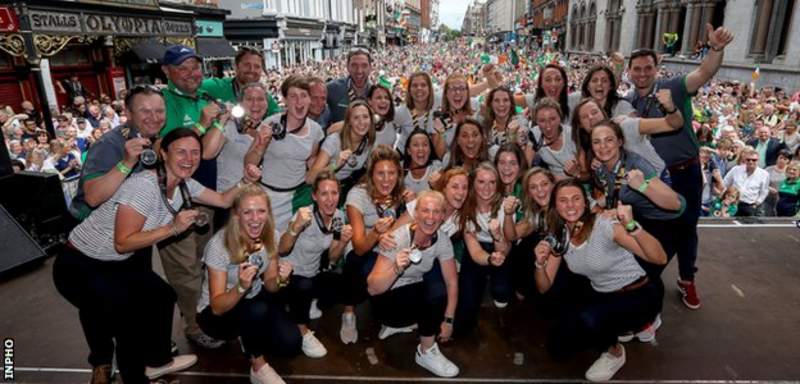
Murphy was a key part of the Ireland set-up when the team reached the World Cup final in 2018
"Athletes with specialisms such as drag flicking will need specialist programs that cater to this unique skill.
"Most importantly the athlete themselves are central to all of this, their behaviours, beliefs, expectations, stress and work/life balance will all effect how they interpret, cope with and return from injury.
"The aim isn't just to get someone back on the pitch playing again, we aim to return an athlete from injury to their pre-injury level of performance or better."
"In order for the relationship to work the athlete has to be responsive and in the case of the hockey squad that hasn't been a problem.
Murphy adds: "This is a fantastic group to work with, they love hockey, they give it their all, and they are always questioning things and keen to improve.
"They have all taken to the task of replicating a high performance training environment at home as much as possible.
"They are used to top class facilities in SNISI and Sport Ireland and have shown a great ability to adapt and still get the work done.
"In a situation with so many unknowns and undoubted stress in and away from sport they continue to train individually and keep good spirits.
"They are a great source of support for each other and a motivation for anyone working with them."
Constant communication in rehab
Ulster's Zoe Wilson has been rehabbing a knee injury since helping Ireland qualify for the Olympics last November.
"When I injured my knee, throughout the rehab I think I saw more of Roisin than my own family," Wilson laughs.
"We've had a lot of communication with her since we have been in lockdown (some of us more than others). She has been providing us with individual 'work-ons' to help make us more robust for when we return to the pitch," she explains.
Murphy has been working closely with Ireland international Zoe Wilson as she continues to recover from a knee injury
"Roisin is a top-class physio that works with the utmost professionalism but has the ability to have a laugh when the time is right.
"She always goes above and beyond to make sure everything is just right for each athlete personally and their program.
"She has introduced us to a side of physio that I believe has brought us to the next level, by making us aware of the importance of both pre-hab and rehab programmes which allows us to increase the intensity of our hockey program."
Being able to gather together and get back to socially distanced training may hopefully only be a few weeks away and as well as looking forward to getting back on the pitch with the team, Murphy is also making plans as to how her job might look for the foreseeable future.
"The current social distancing guidelines have meant a significant shift in our way of working, with telecommunication the primary method of clinically interacting with the athletes," Murphy says.
"I thoroughly enjoy my work and love the social interaction of working with people and teams, but I can see a lot of positives in my work situation in the past few months, the ability to look at the bigger picture, review and reassess.
"The different methods of communication and the importance of each one of them. The benefit and many uses of technology through the novel use of Tele-consultation and rehabilitation.
"I have used videos, pictures and even apps to build programs to educate and communicate with athletes, trialling and tailoring various methods of communication depending on the audience.
"I can see a lot of these ways of working will still be beneficial post-Covid-19."
And when, hopefully, the Irish Women get to make their Olympics debut in Tokyo next summer, it's clear they will be as well prepared as any nation.
BBC Sport
Mashitah seeks redemption with a new goal
KUALA LUMPUR: Goalkeeper Mashitah Abdul Khalid was down in the dumps when no team wanted her services in the Malaysian National Women’s Hockey League in January. It was all the more disheartening because she had helped Selangor win the Razak Cup title last August.
But she’s all smiles again now. The 20-year-old player was called up for national junior training in March for the Junior Asia Cup in Kakamigahara, Japan, which was scheduled for April but has since been postponed.
Mashitah was on cloud nine for receiving her first ever call-up for national training.
“It was a dream come true for me as I always wanted to play for Malaysia. I will fight to win a place in the national junior team,” said Mashitah, who also helped Petaling Jaya City Council (MBPJ) Black Widow to win the Malaysian Junior Hockey League (MJHL) league title last May.
The MBPJ team also finished as runners-up to Tunku Mahkota Ismail Sports School (SSTMI)-PKS for the overall cup in MJHL.
“I believe I was called up for national junior training despite not playing in the National Women’s League this year because there are only a few good women goalkeepers in the country.
“I want to be one of two keepers selected for the junior meet, which is the qualifying tournament for next year’s Junior World Cup (in Potchefstroom, South Africa),” said Mashitah.
The other two goalkeepers called up for training are Siti Zalia Nasir and Siti Mardiana Ahmad
Zaila played for Malaysia in the Indoor Asia Cup in Chonburi, Thailand last year while Mardiana is a newcomer in the team.
Mashitah, whose idol is national No. 1 keeper Farah Ayuni Yahya, took up the sport when she was 12 because of her parents’ encouragement.
“But I started playing as a goalkeeper because of Farah.”
The Star of Malaysia
Sharkia Women's team walk in the same side of the men
By Ahmed Talaat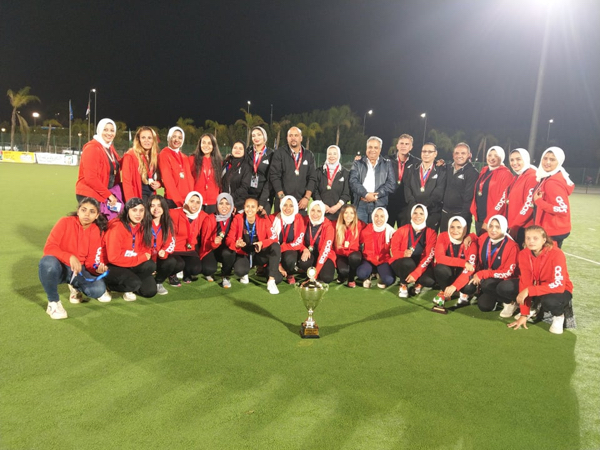
Sharkia Women, African Club Champions 2019
As head coach of Egyptian team Sharkia I had very hard job with women's team. It was very big challenge to all the coaches to develop women section.
We wanted to make them better and be like the Men's team in my club to be top of Africa, to walk on the same side of success, especially since the Women's clubs in the other countries in Africa are better as they were few steps forward. Our problem was the competition here it's little bit weak with no international team or international experiences, so I had to spend more than 2 years hard work with good crew.
It was hard job but in the in the end we achieved good progress, Basic skills, tactics - we were ready for the competition
We won the African Championships for clubs held in Ismailia, Egypt from 1-8 December 2019 capturing the Gold medal for the first time in our club's history.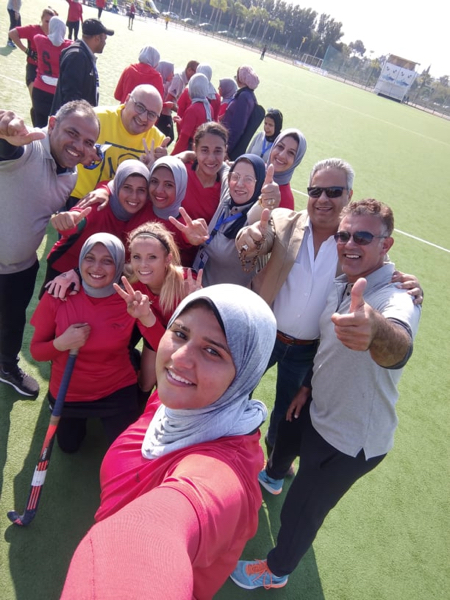
We hope that will encourage the Egyptian National Association to let us share in the African tournament in the future.
Fieldhockey.com
Hockey Legend Balbir Singh Senior remembered
by Dil Bahra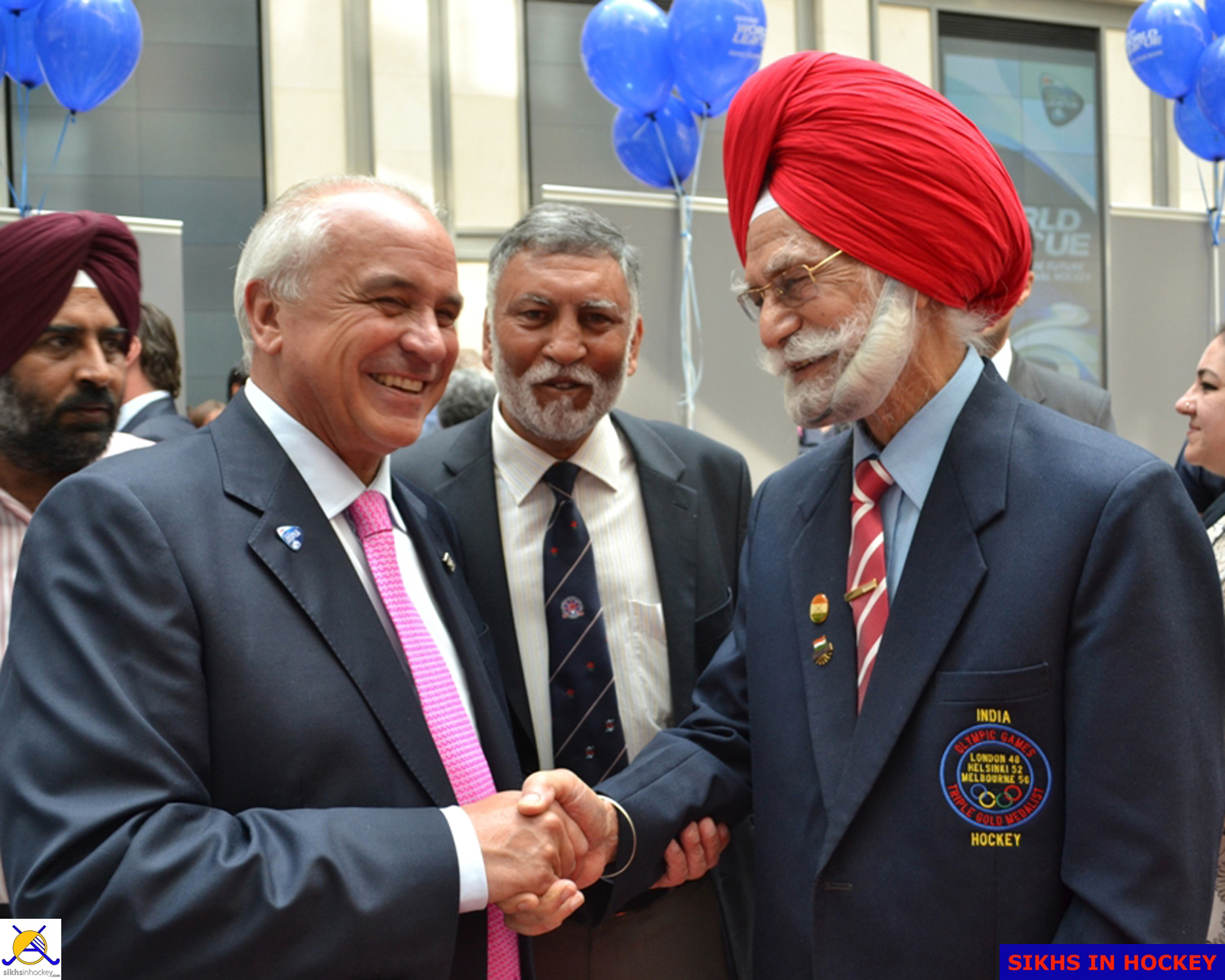
Leandro Negre, Dil Bahra and Balbir Senior at FIH function London 2012 Olympics
I first met Balbir Singh Senior at the Champions Trophy in Amstelveen, Netherlands in 1982. I was with a group who had earlier gone to the Bombay World Cup in that year. Whilst we sat down in the lounge after the match, having our drinks, Balbir, who was the coach of the Indian team at that tournament, was passing through the lounge on his way out. He noticed our group and came over to talk to us.
Four years later, we had the Hockey World Cup in Willesden, London. I was one of the members of Phil Appleyard’s organising committee and was delighted to hear that Balbir Singh was invited as a guest at the World Cup. Balbir attended every day without fail and was always seated in the VIP area of the main stand. Phil Appleyard had asked me to personally look after Balbir. Phil Appleyard made a point of greeting him personally everyday as well. It was during this period that I really became to know Balbir as a person. It is here that I learnt that he was a Police Officer in Punjab in his early days. As I was a Police Officer, I made this fact known to my colleagues who were on duty at the stadium and he was greeted by them every day after that. He presented me with his book, The Golden Hat Trick, which he signed (dated 10.10.1986). He used to travel from Hounslow to Willesden by public transport. He met several hockey supporters in the Centenary Club Lounge after the day’s matches and also attended The Khalsa Centre Tooting with my wife Pami and me. The congregation which included hockey players, old and young were delighted and he was invited to speak to the congregation. He was an excellent speaker, both in English and Punjabi. He was quick to notice that most of the people in the congregation were from East Africa and told them how proud he was of their achievements and how he followed hockey in East Africa.
After the World Cup in London I kept in contact with him, occasionally meeting him during his stopovers in London.
Trafalgar Square, London 2005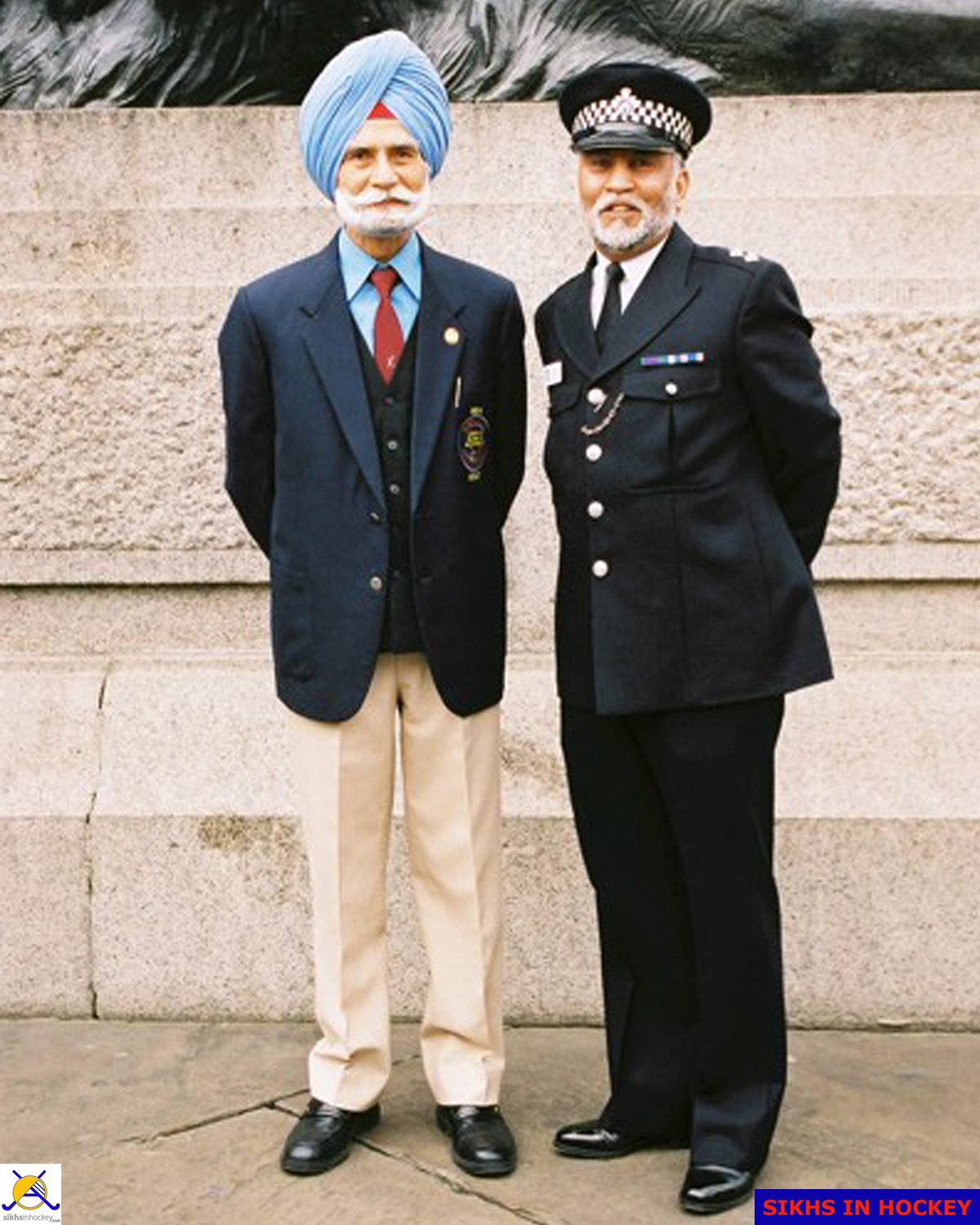
Balbir Senior and Dil Bahra in Trafalgar Square - April 2005
In January 2005, when London was bidding to host the 2012 Olympic Games, I was invited to be a member of the ‘Vaisakhi in London Steering Group’ and given the task of identifying all Sikh Olympians living in the UK to celebrate their achievements and to support London’s bid to host the 2012 Olympics. As a result of my extensive research, with assistance from Patrick Rowley, Bill Colwill OBE and Peter Luck of the Hockey Writers’ Club, I was able to compile a list of all Sikh Olympians and establish that most of the Sikh Olympians living in the UK were hockey players though there were also three wrestlers and a weightlifter. It was our fortune that Balbir Singh would be passing through London to his way to Canada around that time and arrangements were made to include him in our celebrations.
In company with Malkit Singh Sondh, the Ugandan Olympian (Munich 1972), I visited Balbir at his sister’s house in Hounslow and informed him of my proposal. He immediately agreed to be our chief guest and to make a speech at a dinner event for the Olympians and guests at the Indian Gymkhana Club in London.
The invitation list to this invite only function of about 150 people included Patrick Rowley, who was the Chairman of the Hockey Writers’ Club at the time, whilst I was the Secretary. Pat, one of the most senior hockey writers in the world and now honored with a BEM, was also asked to speak at this function. He started his speech by recollecting “My first Olympic Games was in 1948. I was only a schoolboy but I persuaded the sports editor of the local paper, the Middlesex Chronicle, to include some words of a schoolboy’s view of the 1948 Olympics. I could have used all the few words at my disposal on India’s over whelming victory over Britain in the final. I and GB were mesmerised by the Indian centre forward, Balbir Singh. My love of hockey started - that day”. Pat went on to say how much he had admired seeing Balbir play over the years.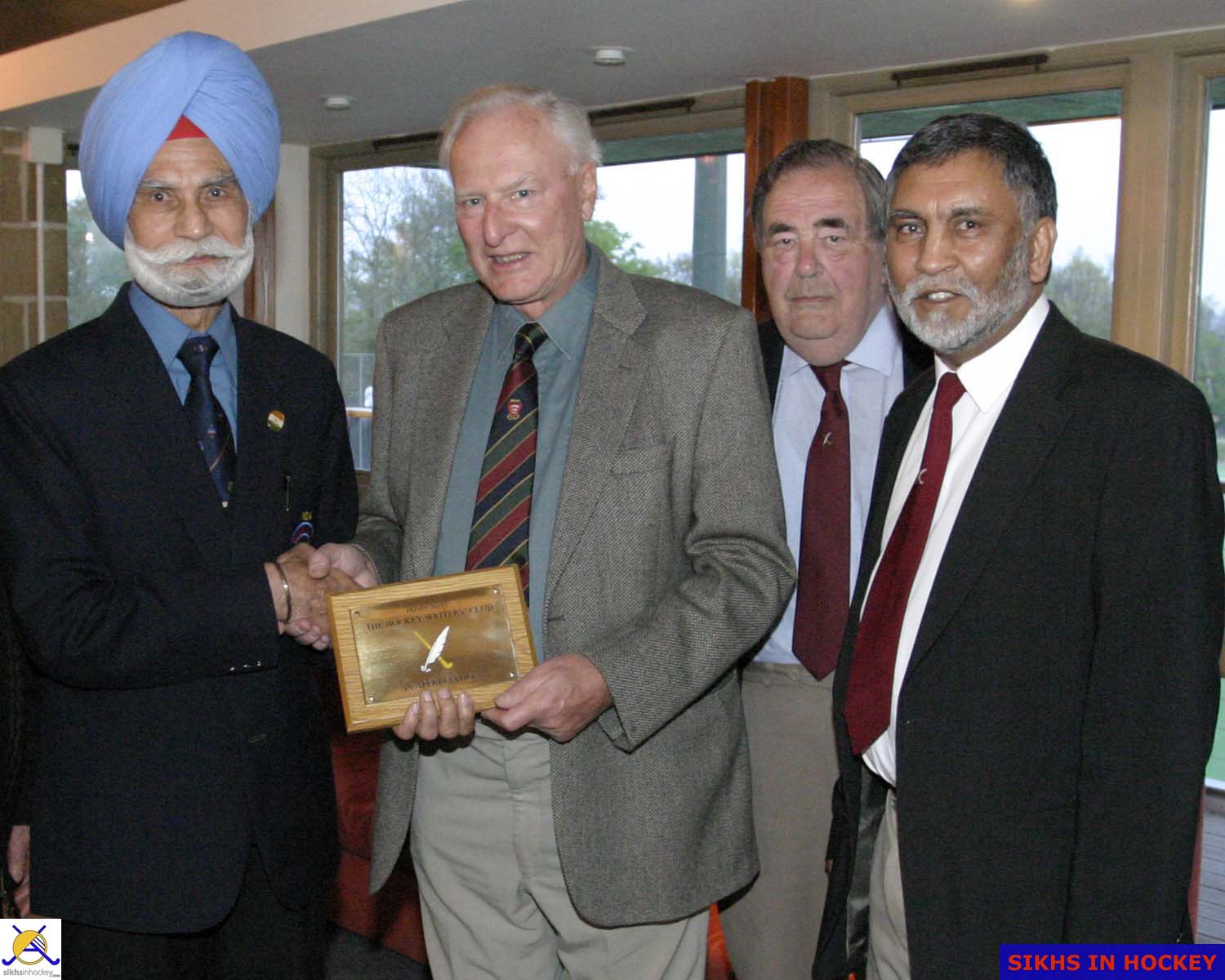
Balbir Senior, Pat Rowley, Bill Colwill and Dil Bahra at Hockey Writers' Club presentation in April 2005
The Officers of the Hockey Writers’ Club, knowing that Balbir was in London that week, took the opportunity of making him an Honorary Life Member of the Club. As Secretary of the Club I was involved in the process and present at the awards function at Southgate Hockey Club.
The successful dinner event was followed a week later with London seeing the biggest ever gathering of Sikh Olympians in Trafalgar Square on Sunday 24 April 2005. Balbir was one of the players to grace the occasion. And as we all fondly remember, London did win the bid to host the 2012 Games.
Mike Hamilton, the well-known hockey journalist from New Zealand, who saw a photograph of Balbir and me in a Hockey Writers Club newsletter contacted me to tell me that he remembers Balbir as a young boy when Balbir stayed at their house in the mid-fifties. He asked me to pass on a message to Balbir, which read “my love for the game of hockey all started through my parents and your visit to Christchurch in 1955 as leader of the Indian Wanderers team. Balbir, you were kind enough to give my father, Keith, a pocket patch from a blazer of the team and I have kept it all these years. I am delighted to see you looking so fit and well in the photograph.” I passed this message to Balbir who was obviously delighted and wrote to Mike. Sadly Mike Hamilton passed away in 2011.
As a result of all the information gathered, I decided to research further into the contribution made by Sikhs in hockey all over the world. I had noticed that all records were not recorded. As part of my research, I travelled to the IOC Library in Lausanne and with the assistance of my fellow members of the Hockey Writers’ Club, I had a comprehensive history and record of Sikhs in hockey at the Olympic Games. By the time I went to Chennai for the Champion’s Trophy in December 2005 my records were nearly complete. Two of my good friends, Prabhjot Singh of the Tribune and Pargat Singh, the Hockey Olympian, who were both in Chennai convinced me to visit Punjab in February for the India v Pakistan series. Pargat, who was also a Police Officer and Director of Sports in Punjab at the time, offered to host my visit.
In order to obtain more information, I travelled to Chandigarh in February 2006. I met Balbir, Sushbir, his daughter and his son in law Retired Wing Commander Malvinder Singh Bhomia at the hockey stadium and Balbir invited me to his house for lunch the following day. He also introduced me to Tarlochan Singh Bawa, his teammate at the London 1948 Olympics. Prabhjot had also invited Balbir and me to the Tribune Offices later that evening. I was so pleased to note that at his house Balbir had a framed photo of him and me at Trafalgar Square in 2005.
The series with Pakistan moved to Jalandhar and Balbir Senior put me in contact with Balbir Services who lived in Jalandhar. Balbir Services invited me to his house for breakfast before the hockey match that afternoon. I saw the Jalandhar match with both the Balbir’s and they introduced me to several Sikh Olympians who were at the match.
It was during this period that I truly realised the achievement of Balbir Singh Senior in the hockey field. I consulted him on many occasions, particularly in relation to names and identifying photos from the past. He was always very helpful despite phone calls at all times of the day, bearing in mind that he was either in Canada or India. I had a comprehensive history of all the Sikhs world over who had played hockey at Olympic Games.
Top Sikh Hockey Player of all time.
In April 2006, I was invited by journalist and author, Sundeep Misra to be a member of a select panel to choose “the Top ten Sikh Hockey Stars of all time”. My fellow judges, in New Delhi, were the former Indian Supreme Court Chief Justice J S Verma (Chairman); four-time Olympic Medallist Leslie Claudius; three-time Olympic Medallist Col Haripal Kaushik; two-time Olympic Medallist R S Bhola; Former Sports Editor of The Press Trust of India K Jaganadha Rao; Hockey Writer of The Hindu S Thyagarajan; Hockey Writer of The Tribune Prabhjot Singh and former Indian Hockey Federation President I M Mahajan.
Ashwini Kumar, the former President of the Indian Hockey Federation, was the Chief Guest at a ceremony at The Ashok, New Delhi on 26 April 2006. Ashwini announced Balbir Singh Senior as the top Sikh Hockey Player of all time and the top Ten Sikh hockey stars were all felicitated. Ashwini was able to tell me, first hand, the contribution Balbir had made to hockey and I had an opportunity to cross check a few facts with him.
On his way to Canada, Balbir stopped over in London as he always did. On hearing of his award, The East African hockey players living in London decided to hold an event to honour Balbir for being selected as the top Sikh Hockey Player of all time. The event, organised by Malkit Singh Sondh, at Shalimar Hotel in West London on Sunday 14th May 2006 was attended by over 150 guests, which included over 100 past and present players including several Olympians.
I was invited to be the Master of Ceremonies. Balbir Singh in his speech recalled the fond memories he had of London and shared his stories of the 1948 Games. Whilst making a presentation to Balbir Singh on behalf of the Sikh hockey players, Malkit said how proud he was to make the presentation to a hockey legend who was a role model to so many players throughout the world. He was given a truly remarkable, honourable applause. Palwan Singh, a former Indian International wrestler, who fought under the name Prince Mann Singh, recalled how as a youngster he had to queue in New Zealand in the fifties to have a glimpse of the great Balbir Singh.
Gurdev Singh Kullar and Joe Gallibardy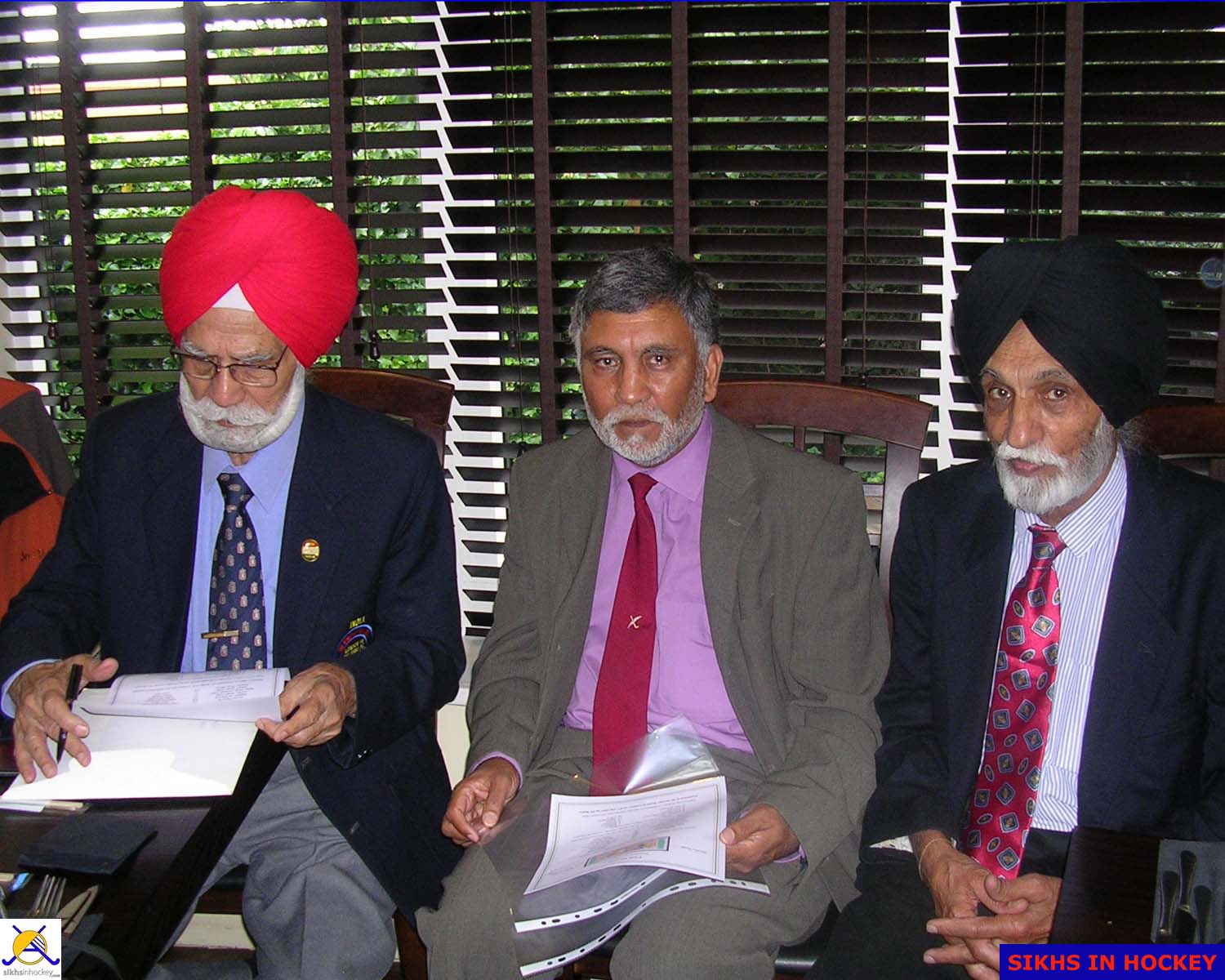
Balbir Senior, Dil Bahra and Gurdev Singh Kullar in 2007
I retired from the Police Service in January 2007 after 32 years and on retirement I set up my Sikh Hockey Olympians website, as I was now able to dedicate more time to hockey history. Balbir’s ten days visit to London that summer was a memorable one. He was accompanied by a film crew and I was requested to co-ordinate the trip. It included filming at Milton Keynes Hockey Stadium, Wembley Stadium where we were granted entrance to the stadium although it had been rebuilt since the London 1948 Olympic Games, Park Royal where he had scored 6 goals against Argentina, a trip to Buckingham Palace to watch the Guard Change from the Palace Forecourt.
There was also a trip to Northants on 2nd July 2007, where a reception had been arranged by Midlands sporting fans in honour of Balbir and his sporting achievements. Gurdev Singh Kullar, who was Balbir’s team mate at Melbourne 1956 Olympic Games, Punjab Police and Punjab, was also invited and I had the pleasure of being the Master of Ceremonies at this event and inform the audiences of the achievement of these two hockey greats. This also gave me a unique opportunity of hearing the experiences of these two great players first-hand. They talked about the good old days and I was privileged to listen to these stories.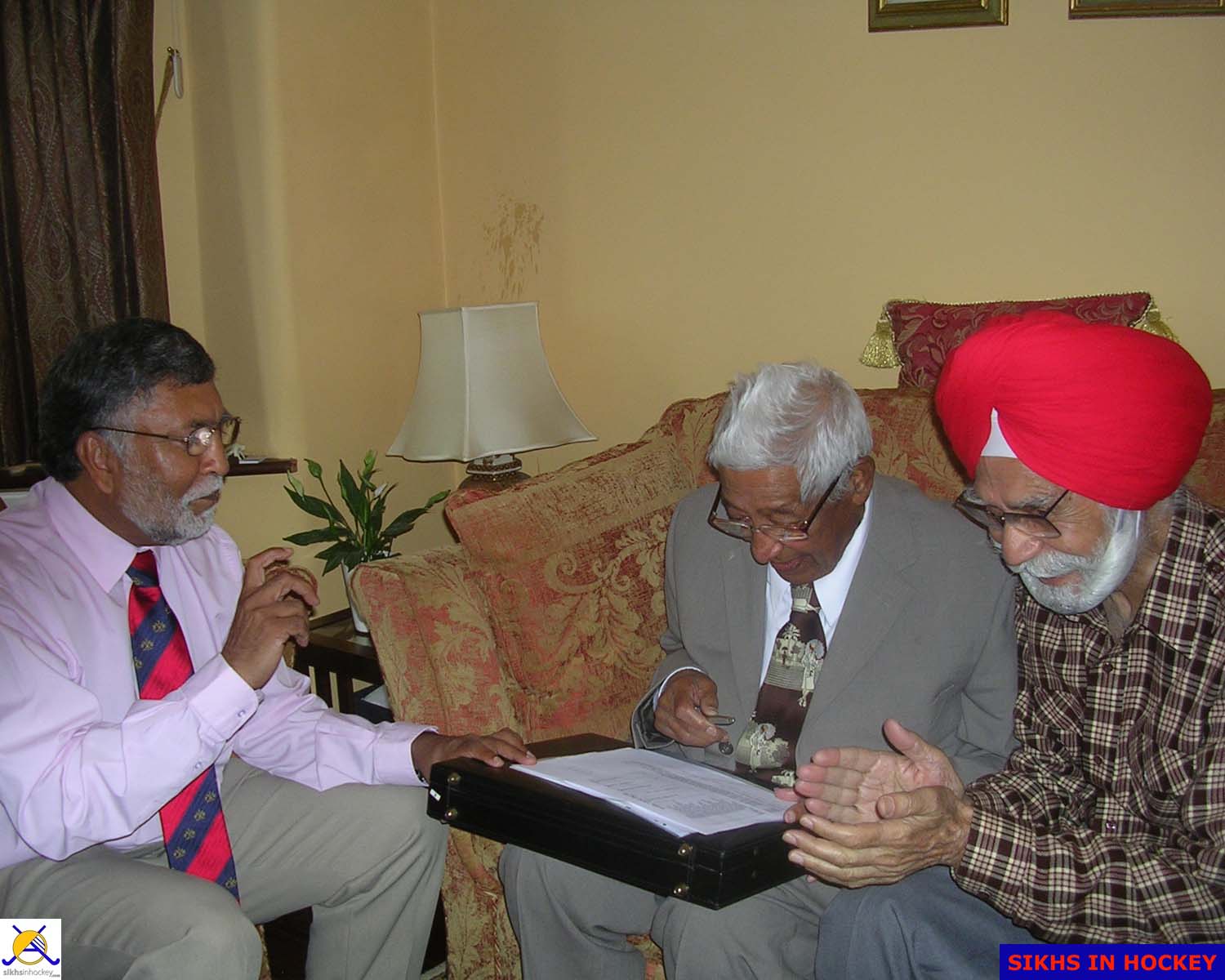
Dil Bahra, Joe Gallibardy and Balbir Senior in 2007
Two days later we met Berlin 1936 Indian Gold Medallist, Joe Gallibardy, at his house in East London. Joe recalled his experiences at the Berlin Games and also checked my records together with Balbir. Hearing the two discuss their training and playing days and the sacrifices they had to make, was a real privilege and to see the mutual respect they had for each other.
His ten days visit concluded with a gathering of his supporters and friends at Indian Gymkhana Club, London.
In August 2008, Balbir wrote to me saying “Your web "sikhhockeyolympians.com" is one more encyclopaedia by you on internet. The first was on paper. I have been reading it frequently. I read the details regarding the 1936 Berlin final. Information printed by you is correct. The facts recorded by FIH on their website are incorrect. Can you do anything about this?”, he asked. I promised him that I would do all I could.
Delhi World Cup 2010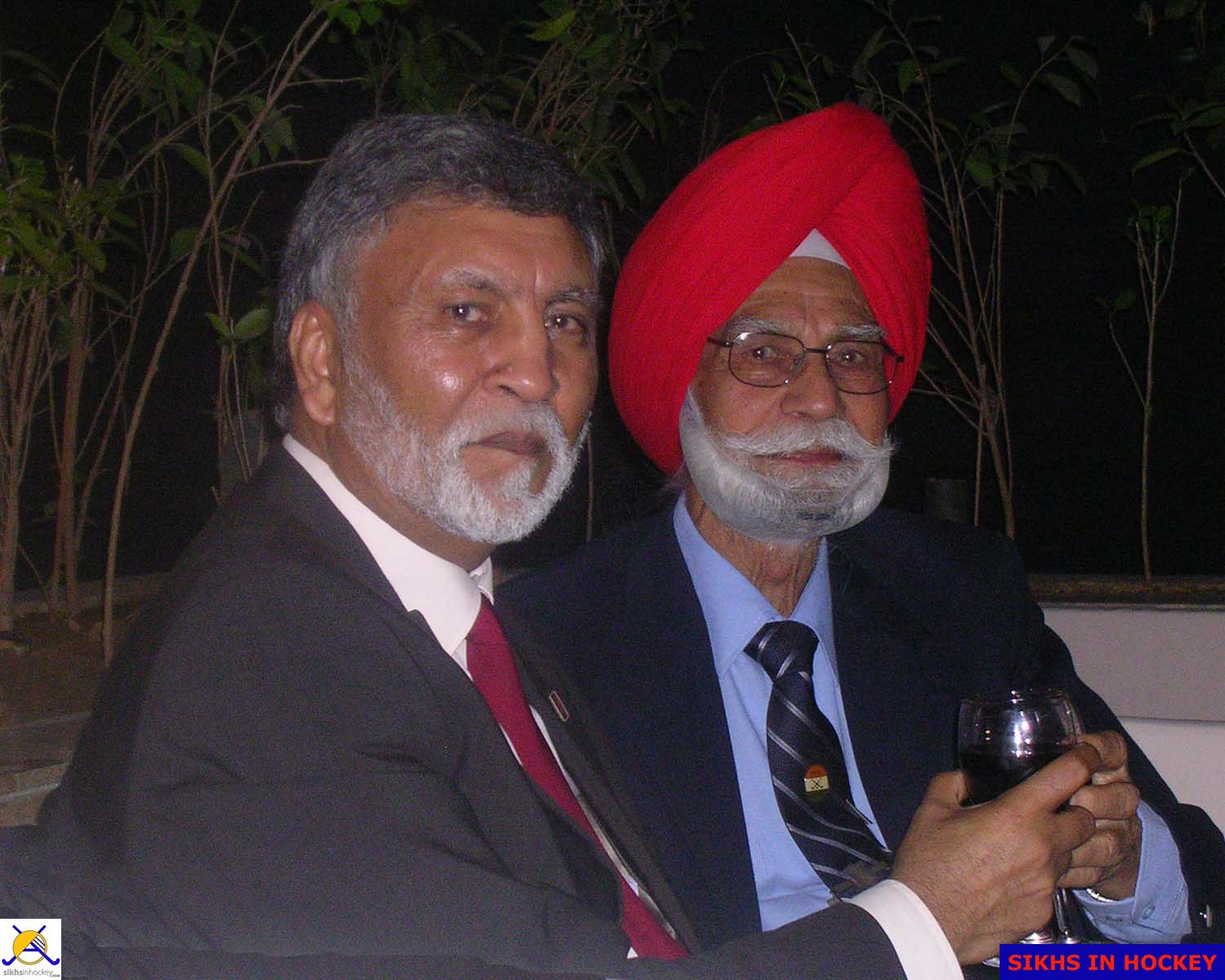
Dil Bahra and Balbir Senior at Tournament Dinner at Delhi 2010 World Cup
I attended the Delhi World Cup as the Media overseer for AIPS Hockey Commission and the FIH. Pat Rowley and I were hosted by journalist Sandeep Nakai at his residence. I had informed Balbir that I would be attending the World Cup. As happens during such major events, invitations to many functions are received and one of these invitations through Sandeep was to “A Salute to Indian Hockey”, organised by Sunil Yash Kalra. Pat and I attended this event with Sandeep with the intention of staying only for half an hour. On reaching the venue hall, I was asked to go out as the Guest speaker wished to see me. I then found out that Balbir Singh Senior and K P S Gill were the Chief Guests. I accompanied Balbir to the hall and after the speeches he came and sat down with Pat, Sandeep and me for dinner and the whole event from there on revolved around our table – the photographs and the autographs of him etc.
A couple of days later, Sunil arranged for a recording of a discussion about Indian hockey between Balbir Singh, KPS Gill and me at K P S Gill’s residence.
I met Balbir on a daily basis at the hockey stadium and we had a long pre-arranged meeting about the inaccurate FIH records with Leandro Negre, President of the International Hockey Federation, whom I knew very well from my appointments as the FIH Media Officer and Secretary of The Hockey Writers’ Club. Leandro, an Olympian himself, took personal responsibility of getting the FIH records checked and corrected.
Leandro Negre, true to his words, ensured that the error was rectified and that the correct results were recorded by the FIH. Balbir was informed personally of this by letter with a copy to me.
The FIH, in that written correspondence on 24 February 2011, confirmed that “The record of the most goals scored in an Olympic final belongs to India's Balbir Singh Dosanjh 'Senior,' who scored five goals in the 1952 final in Helsinki on 24th July 1952, when India defeated Holland 6 - 1."
London 2012 Olympics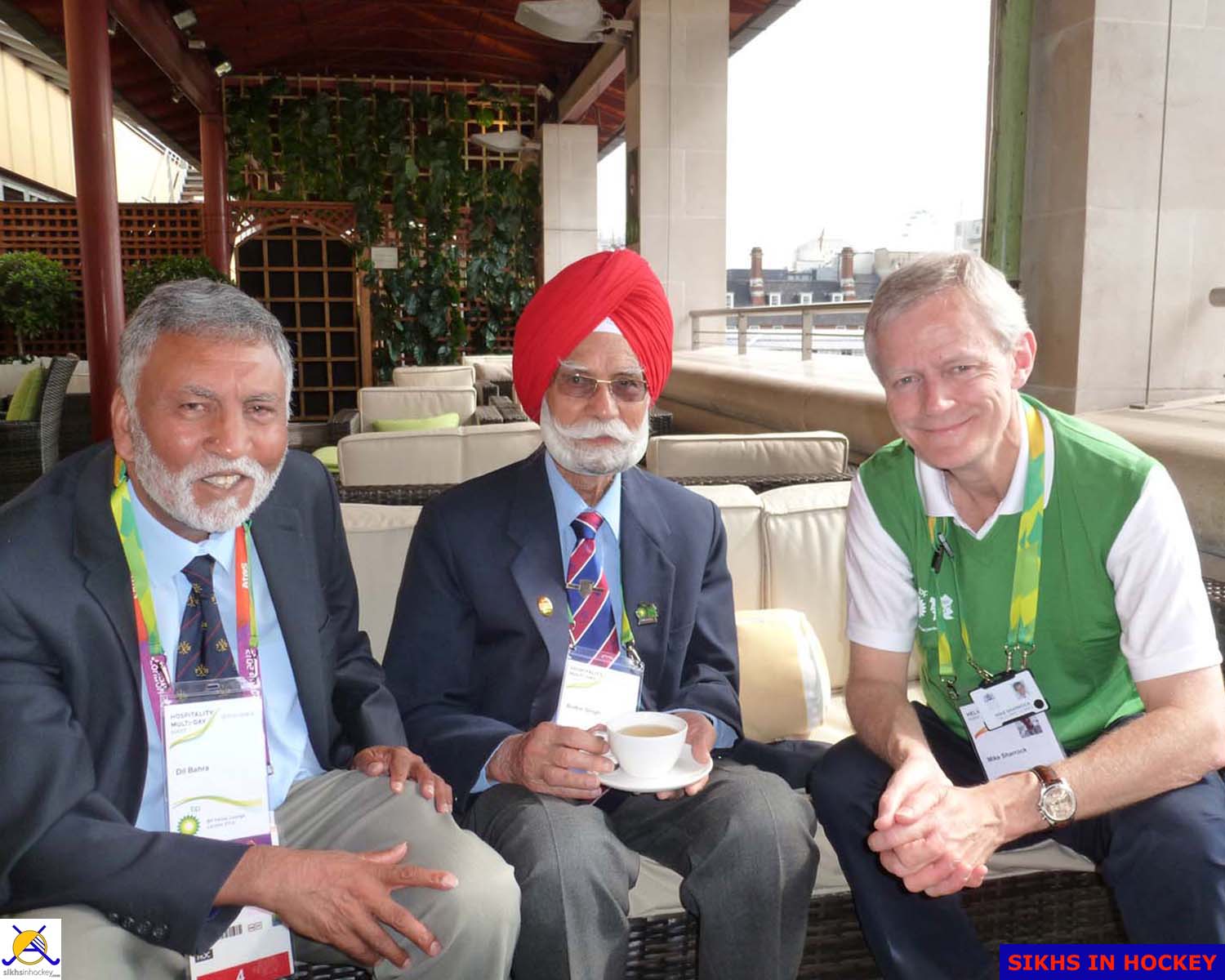
Dil Bahra, Balbir Senior and Mike Sharrock at Royal Opera House in 2012
The Olympic Journey: The story of the Games was a free and unique experience specially created by The Olympic Museum in collaboration with the Royal Opera House and BP, and was part of the London 2012 Festival. It showcased some of the incredible artefacts and images from The Olympic Museum in Lausanne and told the story of the Olympic Games from its creation in 776BC through to the London 2012 Olympic Games.
The stories of the representative 16 athletes were told through interviews, historic footage, photographs and artefacts. Each story tells of human strength and endeavour, of passion, determination, hard work and achievement and demonstrates the values of the Olympic Movement; respect, excellence and friendship. Balbir Singh was one of the 16 athletes chosen, the only one from India and hockey. I was thrilled that Balbir was one of these athletes chosen.
I acted as the co-ordinator/liaison officer for Balbir and attended the first filming at the Royal Opera House. After this interview, we met Mike Sharrock, Partnership Director, London 2012.
I was one of the founders of the Hockey Museum which had been set up a year before and as the webmaster at the time and after the interview I wrote an article on the Museum website: “Hockey at the Royal Opera House”.
The Royal Opera House and BP had joined forces with The Olympic Museum in Lausanne to create a unique exhibition telling the Olympic story through the endeavours of ancient and modern Olympians. Hockey was represented in the Olympic story by the experiences of Balbir Singh 'Senior', the triple Olympic gold medallist, who is one of 16 iconic Olympians featured in this free exhibition.
Mike Sharrock wrote to me that evening: “It was a real pleasure to meet the Great Balbir Singh this afternoon and to hear his wonderful story first-hand. We are all very proud to be able to include him as one of the 16 athletes whose stories will be featured in the exhibition during the Olympics. The special historical significance of independent India winning its first gold medal against Great Britain will be especially interesting for visitors to the exhibition in London. I look forward to the opportunity to show you and Mr Singh around the exhibition in a few weeks’ time”.
I visited the exhibition three times with Balbir and Mike Sharrock always made it a point to personally see us despite his busy schedule. I also accompanied Leandro Negre, President of International Hockey Federation to this exhibition.
David Christison, a FIH colleague and Hockey Writers Club member based in Australia read the story on the Museum website and wrote to me saying he had tweeted my museum piece earlier that morning and received a response from former Australian captain David Wansbrough which I would find amusing. His father, Colin, was long-time president of the Australian Hockey Association.
Colin, aged 76 (in 2012), who was Vice President and Treasurer of the Australian Hockey Association from 1984 to 1993 wrote: “You may find this hard to believe, but I actually played against Balbir Singh in a practice match between my club Camberwell and India prior to the 1956 Melbourne Olympics. I took the day off work, illegally, to play at Elsternwick Park and they beat us 13-0. I was centre half and Balbir led the Indian attack. He scored eight goals. The Indian goalkeeper played for us in the second half. Balbir presented me with his stick after the game. How good was that?
That night the Camberwell team were the guests of the Indian team for dinner at the Olympic Village in Heidelberg. This was my first very hot curry. Charlie Morley organised it and Mike Craig, Ric Purser, Bill Horman, Ron Legg, Al C, etc. all played. The next day there was a photo of Balbir and I in a newspaper. I was unaware of that and got caught out as I was supposedly at my grandma's funeral."
When I told Balbir this story he replied: “You have shown me some interesting information about me. No wonder you are an encyclopaedia in more than one aspects of hockey. I wonder how you have so much information about hockey”
Prior to the Olympic Games, I was present with Balbir during his interviews at BBC World Service in White City, BBC at the Olympic Park, “Words of Olympians Patrimonial Collection of Filmed interviews of Olympic Athletes project of the Olympic Museum”, and several other interviews. I also arranged a visit for him at The Hockey Museum where he met John Peake, the Great Britain Olympian who played against him at the London 1948 Olympic Final.
Balbir was invited to the FIH Lunch at Grange Hotel, St Pauls during the Olympic Games to which I had also been invited. Leandro Negre ensured that Balbir was well looked after.
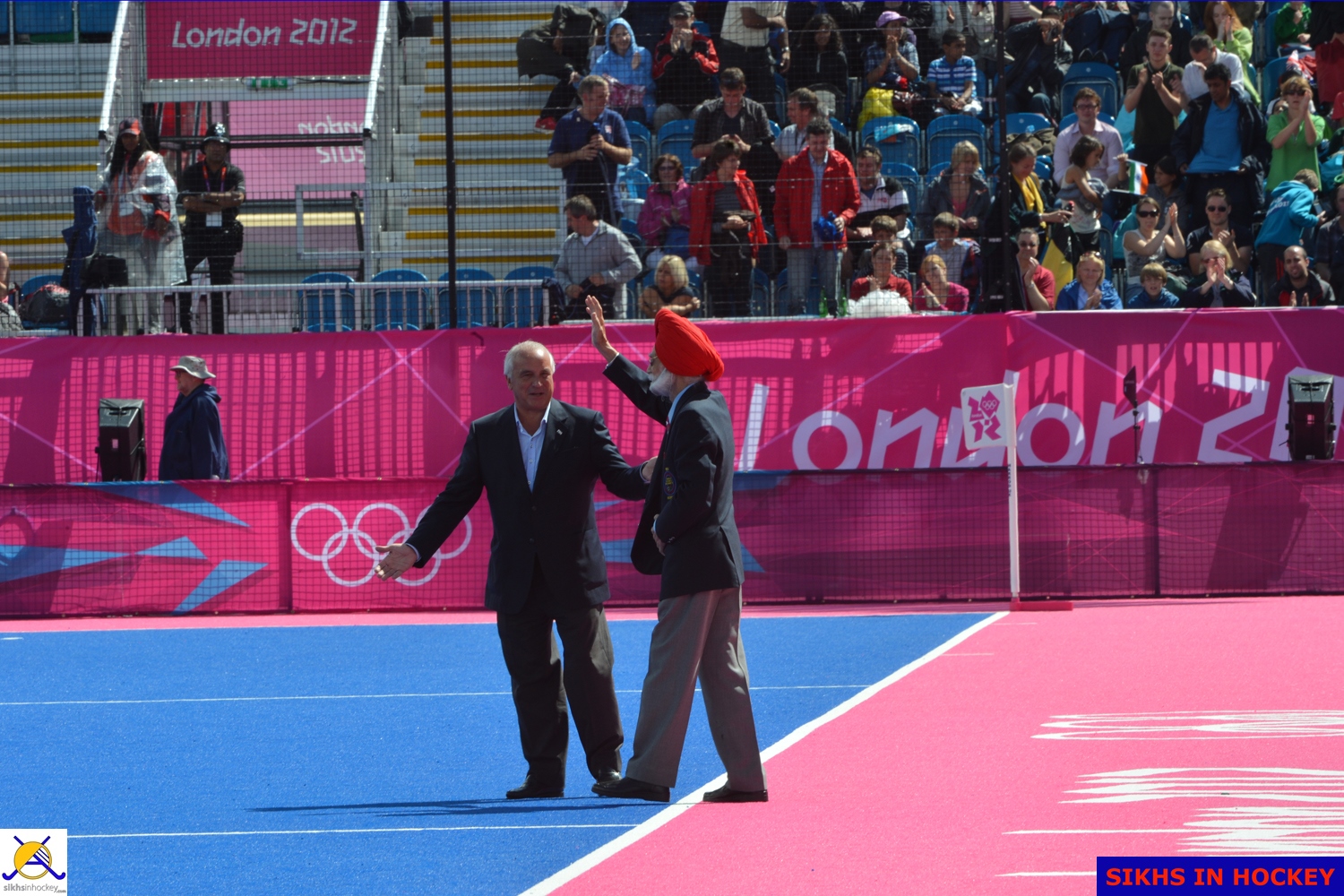
Leandro Negre and Balbir Senior walking on the pitch during half time at London 2012 Olympics
One of Balbir’s highlight of the London 2012 Olympic Games was when Leandro Negro accompanied him to the pitch at half time during a match for him to be interviewed live on TV. He received a fantastic ovation from the crowd.
I kept in contact with Balbir regularly, meeting him on his stopovers in London when he was travelling between India and Canada. Several meeting and interviews were arranged during these visits – like Richard Sayer coming to Balbir to check facts for his book “Master Sportsman – the story of Norman Borrett”. Norman was Great Britain’s captain at London 1948 Olympic Games.
In 2015 when my family were planning a visit to India and he was in Canada, he made sure that Chandigarh was in the itinerary. Unfortunately he was unable to make it to Chandigarh during our visit but never the less we visited his home to the delight of his daughter Sushbir and grandson Kabir.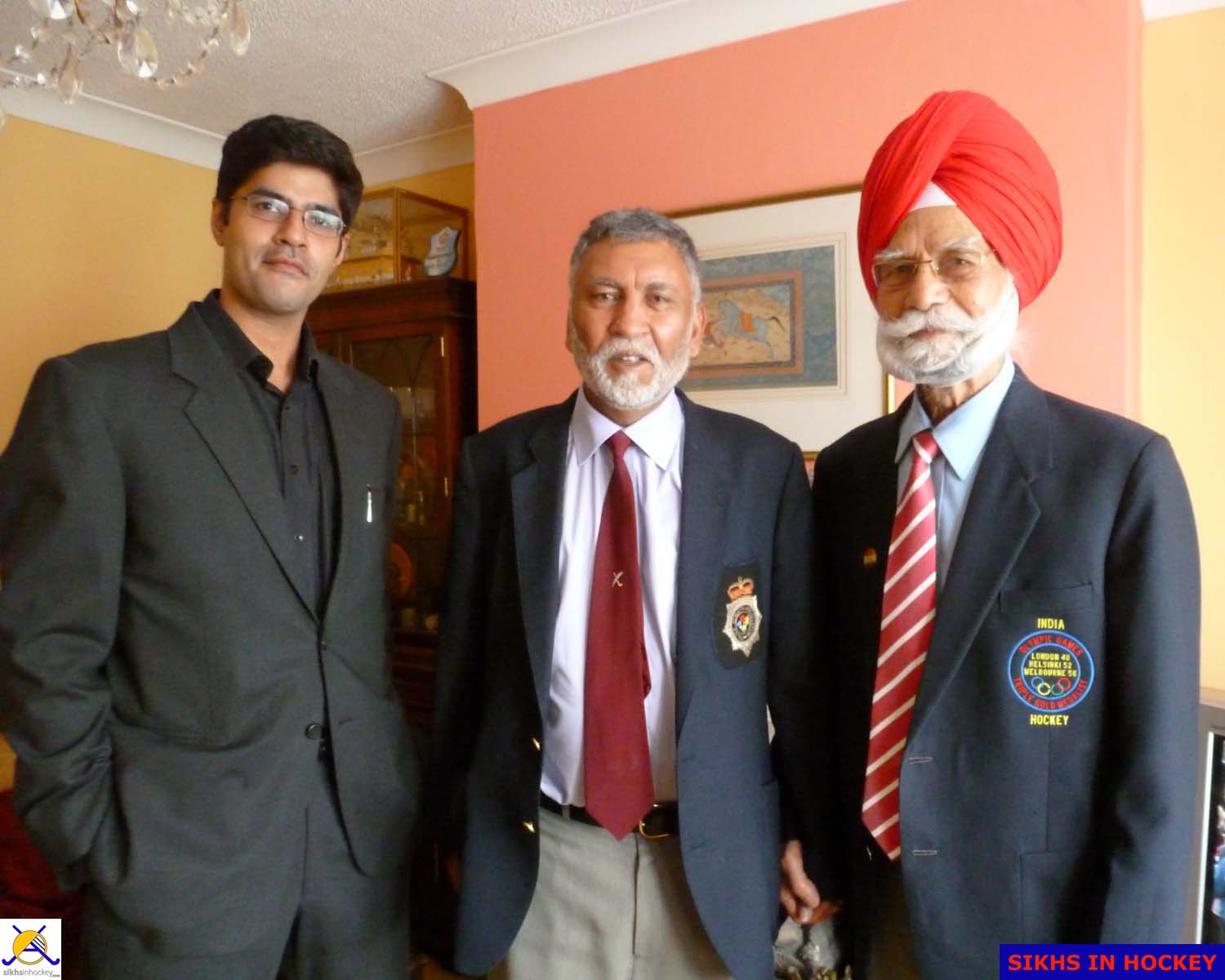
Kabir Bhomia, Dil Bahra and Balbir Senior
I was fortunate that I was able to speak in person with Great Britain Olympian, John Peake who played in the Final of the London 1948 Olympics at Wembley (12 August 1948) where Balbir scored two goals and his team mate also scored one goal at this match, Tarlochan Singh Bawa. And I had the opportunity of talking in person to the late Sir Derrick Day, the Great Britain goalkeeper, about the semi-final match at Helsinki 1952 Olympic Games (20 July 1952) where Balbir scored all the Indian 3 goals. For the Melbourne 1956 Olympics, his team mate Gurdev Singh Kullar, with whom I am still in contact, was able to give me a first-hand account. Mike Craig, the former Australian Captain, who was a commentator during the Melbourne Olympics also shared his wealth of information of the Games with me from his accurate written records.
I last spoke with Balbir via video link on 14 April 2020. It was Vaisakhi day and he wanted to pass on his Vaisakhi greetings personally. We chatted for about half an hour and talked about hockey and our families. He seemed in good spirits as always.
Sikhs in Hockey
Hockey Australia proud to be ‘In This Together’ for NRW
During this National Reconciliation Week, Hockey Australia reinforces its full support of the objectives and journey towards a fully reconciled country.
As stated on the Reconciliation Australia website, National Reconciliation Week (NRW) is a time for all Australians to learn about our shared histories, cultures, and achievements, and to explore how each of us can contribute to achieving reconciliation in Australia. At the heart of this journey are relationships between the broader Australian community and Aboriginal and Torres Strait Islander peoples.
Hockey Australia (HA) proudly supports a number of programs that aim to strengthen these relationships. In Western Australia’s Pilbara region, HA in conjunction with major partner Fortescue Metals Group has been running an ever-growing Community Hockey Program in schools and regional communities. Then there is the Aspire to be Deadly Indigenous Hockey Program run by Cairns Hockey with a focus on helping Indigenous students to ‘Live Well, Learn Well and Lead Well’.
For the first time, HA also held an Indigenous themed weekend during the Kookaburras and Hockeyroos’ FIH Pro League matches against Argentina in Perth back in March this year. The purpose of this was predominantly an awareness and celebration of the past and ongoing contribution of Indigenous people and culture on hockey in Australia.
The theme of this year’s NRW is ‘In This Together’, a theme HA CEO Matt Favier is more than pleased to endorse through the connection and role hockey is playing in assisting to build relationships and communities that value Aboriginal and Torres Strait Islander peoples, histories and cultures.
“This week on the calendar is important for all Australians to take note of and Hockey Australia is fully behind what National Reconciliation Week is about and proud that we can promote this message of unity and mutual respect,” said Favier.
“Inclusion is one of our key values as an organisation and a sport, and this encompassing of all people is something hockey prides itself on.”
“Aboriginal and Torres Strait Islander people have been and continue to be an important part of the hockey community in Australia.
“We respect and acknowledge the traditional owners of this country and look forward to continuing to build on these relationships with Australia’s first people through our support of various programs such as the Pilbara Community Hockey Program and the Aspire to be Deadly Program.”
Significantly, the dates for NRW remain the same each year; 27 May to 3 June. These dates commemorate two significant milestones in the reconciliation journey – the successful 1967 referendum, and the High Court Mabo decision respectively.
For more information on NRW visit https://www.reconciliation.org.au/national-reconciliation-week/
Hockey Australia media release